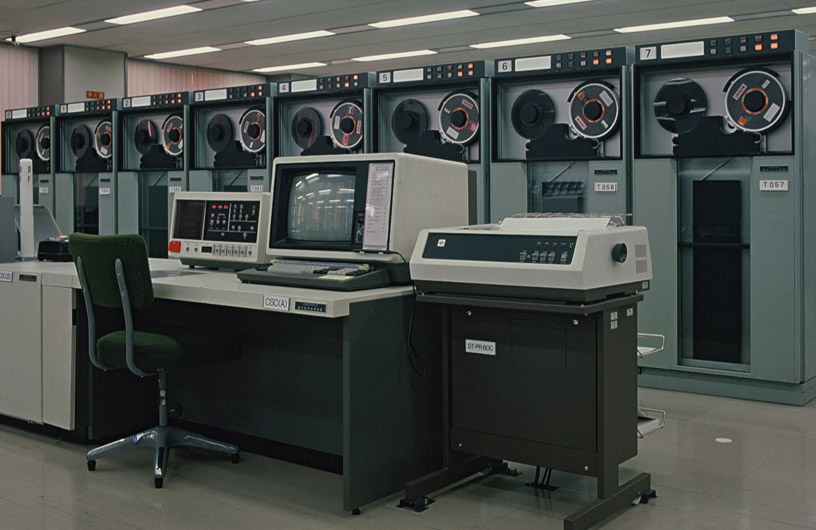
NTT DATA History
Chronological list of past activities, and awards received by our products and services
Our history is traced back over 150 years to the first telegraph service in Japan. The Nippon Telegraph and Telephone Public Corporation then took over the government-run business to support Japan's telephone and communication services over the decades. In 1967, its Data Communications Division was established as an internal organization, marking the beginning of NTT DATA. In 1985, the company was privatized to become NTT, and in 1988, NTT DATA was spun off from NTT. We have since become a major player in the numerous developments of large-scale systems called "social infrastructures" that help progress social transformations. In July 2023, we have shifted to a holding company structure, which is a three-company structure with NTT DATA Group Corporation as the holding company, NTT DATA Japan as the domestic (Japanese) operating company, and NTT DATA, Inc. as the overseas (outside Japan) operating company. With this global management system, we have geared toward further business growth. We are a global organization that supports clients beyond the IT domain, providing end-to-end services and solutions ranging from business transformations to the operations that realize the transformations.
2017-Present
After the Global 2nd stage, we aimed for the goal of the Global 3rd stage of becoming a “Trusted Global Innovator.”
“Looking to the future”
When we entered the Global 2nd stage in 2017, we aimed to establish our local presence further, to grow as a global brand. This was based on the Global 1st stage, where we focused on expanding our global coverage mainly into the US and EMEA regions.
In line with the previous Mid-term Management Plan (FY2019 - FY2021), we strived to improve profitability of our operations outside Japan and accelerate digital initiatives further to reach the Global 3rd Stage in 2025, aiming for global and quality growth with unchanging beliefs and the courage to change.
Under the slogan of "Realizing a Sustainable Future," our new Mid-term Management Plan formulated in 2022 aims to create new value toward realizing a sustainable society by further enhancing our power to "create" and power to "connect," and by combining these two strengths.
Power to "create": our capability to create systems with in-depth client understanding and
advanced technologies.
Power to "connect": our capability to support diverse corporate systems and industry infrastructures.

- 2023
-
- Management
- Selected "NTT DATA GROUP CORPORATION" as Name of Holding Company and "NTT DATA JAPAN CORPORATION" as Operating Company in Japan.
- 2022
-
- Management
- Integration of NTT Group's overseas operations.Establishment of NTT DATA, Inc.
- Management
- Launched Innovation Center in Six Countries.These local centers, situated in countries where customers have high sensitivity to the latest trend, will focus on leading-edge technologies with the potential to become mainstream within five to ten years, aiming to generate new business through joint R&D with such customers.
- Services
- NTT DATA and SAP Announce Co-Innovation Solution to Track Fragile and Sensitive Cargo Shipments and Facilitate Insurance Procedures.
- 2021
-
- Services
- Began providing "Zero Trust Security Service" globally. This service provides organizations with a working environment tailored for the post-Covid-19 "new normal" of flexible working styles while supplying a high level of security for different devices and cyberattack responses.
- Management
- NTT DATA becomes the first company in Asia to join the Green Software Foundation as a Steering Member. The organization is dedicated to reducing CO2 emissions from software. By entering this, NTT DATA hopes to achieve its Carbon-Neutral Vision 2050.
- Management
- Launched NTT DATA EMEAL, a new operational company for Europe, the Middle East, Africa, and Latin America. The move brought together 38,000 employees from across 25 countries.
- Management
- Established a new brand "SocietyOS ™" to help realize Smart Cities. "SocietyOS" develops services from the consumer's point of view and is designed to aid city development in the digital and COVID-19 age.
- 2020
-
- Services
- Launched a community cloud service designed for Government clients. "Open Canvas for Government" will provide a high security and operational quality platform that can reduce costs, scale to requirements, and have high agility to respond to client's needs.
- Services
- Launch of a new agile development-related training for total agile transformation for companies. This makes it possible for training tailored to the customer's digital transformation (DX) initiative stage.
- Services
- Free provision of diagnostic imaging AI data to combat against COVID-19. Through utilizing this data, medical institutions will be able to better detect COVID-19 and improve patient triage
- Technology
- Begin enhancing and providing functions of solutions against COVID-19 for severely strained healthcare institutions across the globe. These include the ehCOS Remote Health, a cloud-based solution for hospitals for remote healthcare.
- 2019
-
- Management
- In preparation for the Tokyo 2020 Olympics, a total of 75,000 people participate in "Telework Days" for 10 days, in preparation for more future changes to work style.
- Management
- Acquired the first Japanese certification of a business to collect and anonymously process detailed medical information, including electronic medical records for research purposes. The aim is to help enhance the level of medical care and accelerate pharmaceutical R&D.
- Management
- Received "Best Supporter Award" at JSUG Conference 2019 in recognition of NTT DATA's contributions to the Japan SAP User Group.
- Technology
- Demonstrated how AI can predict future traffic conditions and jams based on the latest road conditions, available in a free app for regular users.
- Technology
- Started a lab to research quantum computing and next-generation architecture. In the future, NTT DATA will utilize this technology to solve problems that were previously not possible. NTT DATA aims to offer services in the financial, transportation, and logistics industry, among others.
- 2018
-
- Management
- Achieved consolidated net sales of 2 trillion Japanese Yen, made possible through continuous enhancements made to NTT DATA's business capabilities
- Management
-
30th Anniversary of NTT DATA, bringing in the new group vision of "Trusted Global Innovator".
This new vision states that:
We realize the dreams of our clients around the world through long-term relationships.
We develop evolving ecosystems with our clients through leading-edge technologies.
We enhance our creativity by respecting diversity.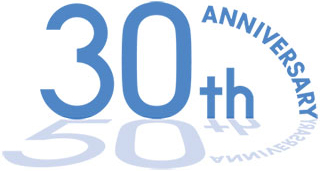
- Technology
-
Digital business design studio AQUAIR opened. The studio is designed to seamlessly realize client's digital business planning and demonstrate experiments. Visitors can experience the latest in technology and working styles.

- Management
- Release of rare materials archives for the learning and research of valuable materials, with easy search and browser functions.
- Management
- 33,000 employees participated in "Telework Days" over 5 days. This is part of NTT DATA's initiative to change the ways we work and improve teleconferencing services.
- Management
- Created new employment categories to create new services, to strengthen the recruitment of external human resources. This was in response to the expansion of IT-related investment in the industrial world and the higher need for expertise in advanced technology fields.
- Technology
- Globally implemented Endpoint Detection and Response (EDR) services to promptly respond to any large-scale cyber threat such as viruses or hacking.
- 2017
-
- Services
-
Launched the new global business system to reach the "Global 3rd Stage" by 2025. NTT DATA aims for global and quality growth through unchanging beliefs and the courage to change.
This will be achieved by increasing the four powers of Growth, Earnings, Transformation, and Synergy.
- Services
- Partnered with Mitsubishi Heavy Industries to form NTT DATA MHI Systems, with a focus on information systems to make IT infrastructure construction, operation, and maintenance more efficient.
- Management
-
Established the BeSTA FinTech Lab to create new financial services through the transmission of information, creation of new business ideas, and promotion of projects.

2005-2016
Global Strategy Period
“From Strengthening Alliance to Expanding Overseas Business”
To further grow our business in a globalized and rapidly changing world, it was time for us to establish a new NTT DATA Group as a “Global IT Innovator”.
With this new vision, the company strengthened alliances within Japan through cooperation with client’s IT departments.
Our strategy has been evolved from focusing on IT support for Japanese companies to developing a long-term strategy targeted at the world’s largest markets: North America, Europe and Asia-Pacific. At the same time, we have developed global business by aggressively expanding overseas business and developing technology abroad through M&A.

- 2016
-
- Technology
-
Completed the delivery of the CBM-NET System, the first core IT system implemented for the Central Bank of Myanmar. This helped streamline bank operations by systemizing government bond transactions, which were previously done manually on paper.
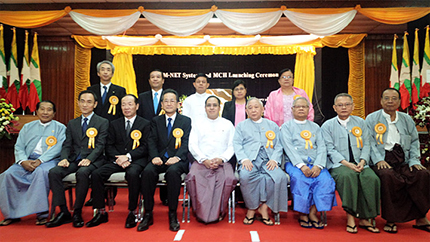
- Technology
-
Launched a virtual reality baseball coaching system, developed in collaboration with Rakuten Baseball Inc. The system aims to raise the performance levels of professional baseball players by placing them in a virtual batter's box, experienced through a head-mounted display.
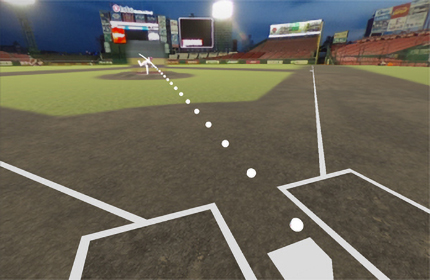
- Management
- Acquired Dell Services, further expanding NTT DATA's presence in North America, bringing the total number of subsidiaries and overseas offices to 274 as of the end of 2016.
- 2015
-
- Technology
-
Started developing a large-scale and high-speed traffic simulation technology using big data. In 2014, an experiment was conducted for alleviating traffic congestion using GPS data. This was developed further in Exeter, UK, by building traffic simulation and traffic signal control technology into an end-to-end congestion management service, aiming to deploy this Smart City technology to more cities worldwide.

- Services
- Entered into a multi-year deal with Daimler for global ERP support services primarily in India and Turkey.
- Management
- NTT DATA to acquire Carlisle & Gallagher Consulting Group to Expand Consulting Services to the Global Financial Services Industry
- 2014
-
- Group companies
- Completed acquisition of Spain-based everis Group by investment. Everis aimed to strengthen NTT DATA's IT services from around the Spanish-speaking world.
- Technology
-
NTT DATA participated in the Digital Archiving of Vatican Apostolic Library Manuscripts project, preserving many ancient texts and manuscripts online.

- 2013
-
- Technology
- Developed forecasting logic in electric power systems, utilizing big data, with Irish Research Institute TSSG. This logic aimed to forecast how much power is needed at any time, how much of that is wind power, and also the transaction price for the power.
- Technology
- Started joint research on noise filtering techniques for Twitter and Sina Weibo with the Chinese Academy of Sciences and software Institute. This would filter out any posts considered "noise" that were not able to be used for analysis and could affect the accuracy of research.
- Services
- Started a foreign currency-denominated card payment service in Japan, along with Global Blue, Mitsui-Sumitomo Card, and Kyushu card. This showed the customer the price both in yen and their home currency, easing any concern they may have had about an unstable exchange rate.
- 2012
-
- Management
-
The Corporate logo was redesigned to reflect the global nature of NTT DATA.

- Services
- Card Payment Comprehensive Network CAFIS® starts supporting foreign currency payments to better accommodate tourists in Japan.
- Services
- Contracted to develop trade procedure and customs clearance systems in Vietnam (VNACCS/VCIS) aiming to streamline procedures by reducing their processing time and centralizing processes.
- Services
- Signed a Firehose agreement with Twitter Inc. on providing Tweet data to other companies to support their marketing, advertising, news reporting, and research.
- 2011
-
- Group companies
- Acquired American IT service company, Keane International, Inc., bringing in their expertise in IT service and important clients such as government and financial institutions.
- Group companies
- Acquired Value Team S.p.A., Italy, to expand know-how in IT consulting, system development in the Telecom, manufacturing, and financial fields, with a look to expand further into Brazil and Turkey.
- Management
- e-Life Business Division achieved the highest possible CMMI level, Capability Level 5, testimony to NTT DATA's commitment to providing customers with high-quality systems and services.
- Management
- Established Business Center in Ishinomaki-city, to create stable employment in areas affected by the Great East Japan Earthquake, to provide reconstruction support.
- 2010
-
- Services
- Achieved the CMMI Maturity Level 4, the first in Japan, in recognition of NTT DATA's highly reliable system development and management processes.
- Technology
- Developed the National Spatial Data Infrastructure for the Indonesian government. This system brought together fragmented data, aiming to enable a more efficient formulation of regional development plans.
- 2009
-
- Management
- NTT DATA was elected as one of the "Global 100 Most Sustainable Corporations in the World" in 2009 in recognition of the efforts made in promoting environmentally friendly business activities, while also acquiring the ISO1400.
- Management
- NTT DATA's internal social media "Nexti" was awarded the "IT Management Innovation Award" for its contribution to innovative in-house communication.
- 2008
-
- Group companies
- Acquired a controlling interest in information systems subsidiary of Nippon Mining Holdings, aiming to further strengthen NTT DATA's presence in IT Innovation by utilizing their track record of system development in the electronics, automobile and software industry.
- Group companies
- Capital tied-up with BMW AG through the acquisition of management rights of IT system Company, Cirquent GmbH, bringing in the vast experience of the IT service provider.
- Group companies
- Completed acquisition of itelligence AG, which focuses on creating tailor-made SAP software to fulfill their customer's needs.
- Management
- Implemented remote working as part of "New Behavior Reform Working Group" initiative where employees are invited to think how they can change their working style and behavior to realize NTT DATA'S group vision.
- Services
- Launched the high-quality IT Platform "Green Data Center Shared IT Platform Service". This service provides users with a shared IT infrastructure, providing a stable software and hardware experience.
- 2007
-
- Management
- Achieved consolidated net sales of 1 trillion Japanese Yen.
- Services
- Allied with DATATRAK Corp. in the United States to perform a clinical trial for Electronic Data Capture service "eClinical". This service aims to speed up the development of new drugs by simplifying data entry, form creation tools, and data extraction, all through a user-friendly interface.
- Management
- Awarded ISO/IEC27001 certification in recognition of proper information security management systems.
- Services
- Started providing "CGM Watch," the first service in Japan that aims to analyze topics on blogs and social media, and report these trends to users. This service could be used for the evaluation of products and services, campaign evaluation, and also the survey of potential rumors.
- Services
- Started providing "Contents Match Mobile," a service that aims to offer contextual advertising per webpage, a first in the world for mobile devices, allying with Overture.
- 2006
-
- Services
- Started "FairCast - Child Safety Communication Network" which aimed to replace a school's telephone network by allowing parents to be contacted through e-mail, telephone, fax, and LINE, all at once.
- Technology
- Started the construction and operation of the "taspo" system which introduced an IC card to be used on tobacco-selling vending machines. These IC cards could only be issued to adults, preventing underage people from easy-access to cigarettes.
- 2005
-
- Services
- Began a joint venture with Yonyou Network Technology to provide IT support for Japanese companies expanding into China. The aim for this was for Japanese companies to grow into Beijing and China as a whole.
- Group companies
- Completed the acquisition of The Revere Group, Limited, which provided total system integration solutions to customers in the United States and helped obtain new clients.
- Technology
- Developed the manufacturing world’s first die inventory management system for stacked-type RFID tags for Nissan Motor Corporation. Adoption of these RFID tags, a first in the world, led to a higher level of accuracy and less burden on workers.
1988-2004
Transformation and Challenge Period
“Establishment of NTT DATA Communications Systems Corporation”
Spinning off from NTT, NTT DATA Communication Systems Corporation was established in 1988.
We became the largest information and communication service company in Japan.
In order to become a “value creator who generates energy from information,” we started our operation in the field of “Information Technology.”
We created new markets by developing systems in different fields such as public, financial and industrial, and then further expanded.
NTT DATA was the first company in Japan to introduce technologies such as Smart cards and virtual shopping malls. This is how we started to build the foundation of the “convenience” and “security” that we have today.

- 2004
-
- Technology
- Developed an information system integration platform and “Target” system for the Tokyo Stock Exchange. This brought together features from the 6 existing information systems, creating a much more efficient flow, service, and overall operation.
- Technology
- Started an integrated ATM Switching Service, interconnecting CDs and ATMs for over 1,300 financial institutions in Japan. The service allowed withdrawals, balance inquiries and transfers amongst others, all online.
- 2003
-
- Technology
- Completed the construction of the i-mode Gateway System "CiRCUS" for NTT. The system allowed 37 million i-mode users to access web and mail services.
- Group companies
- Established a "3D Consortium" with Itochu Corporation, SANYO Electric, SHARP, and SONY, with the aim of expanding the development of 3D development by popularizing 3D devices and content.
- Technology
- Started trial experiments on the use of RFID (wireless IC tag) in the food distribution field with Marubeni Corporation and The Maruetsu, Inc. In the trial, each item of food was attached with a wireless IC tag, so that the flow from shipping to the consumer could be understood.
- 2002
-
- Technology
- Developed the "Xaica-α" the smart card that was able to be used both with contact and contactless. Due to the flexibility of the card, each card issuer could choose their own policies and security tied to the cards.
- Management
- Obtained the Information Security Management System (ISMS) Conformity Assessment Scheme certification, awarded for NTT DATA's proper management of confidential information.
- Technology
- Performed a large-scale "cell computing" experiment, which utilized surplus CPU in Internet-connected PCs in both offices and homes. The trial used the power for research in fields such as biotechnology, space, and astronomy.
- 2001
-
- Management
- Obtained the BS 7799 certification, the international information security standard, a first for a Japanese company. This was awarded in recognition of NTT DATA's commitment to strong information security management.
- Technology
- Developed an authentication system with Mitsubishi Electric that combined a Smart card with fingerprint authentication technology. The technology had a high level of security and can be linked to other payment systems, allowing a large amount of potential business development.
- Services
- Started a joint operation web ordering system for home appliances with SHARP, SONY Marketing, TOSHIBA, JVC, and HITACHI. The system was easy to install and allowed orders from several manufacturers.
- 2000
-
- Services
- Started the Integrated Data Center "EXFORT" service, providing hosting, management and service level guarantees. Operating with the same system as the iDC, this allowed testing before any operation took place, allowing a proper understanding of the system's capabilities.
- 1999
-
- Services
- ANSER started a money transfer service between accounts and banks on the Internet, reducing the burden of system costs through the sharing of equipment and software.
- Services
- Designed and developed an electronic procurement system for the Malaysian government that connects all 24 ministries and agencies, supplying around 24,000 traders access to quick procurement through the Internet.
- Management
- Obtained ISO 14001 certification, awarded in recognition of the promotion of environmentally friendly business, compliance with laws and regulations, and promotion of environmental measures both in and out of the company.
- 1998
-
- Group companies
- Established NTT DATA (China) Co., Ltd., aiming to provide system integration services to customers mainly in Beijing.
- Management
- NTT DATA Communications Systems Corporation changed its name to NTT DATA Corporation.
- Services
- Started development of a card payment terminal, "INFOX" and the information processing center "INFOX-NET", providing secure and flexible payment services.
- Management
- Obtained ISO 9001 certification, awarded in recognition of the quality of services provided to customers by NTT DATA
- 1997
-
-
Launched the interactive 3D virtual shopping mall "Machiko". This hosted over 30 client stores, allowing up to 200 visitors to come together to chat and shop online.
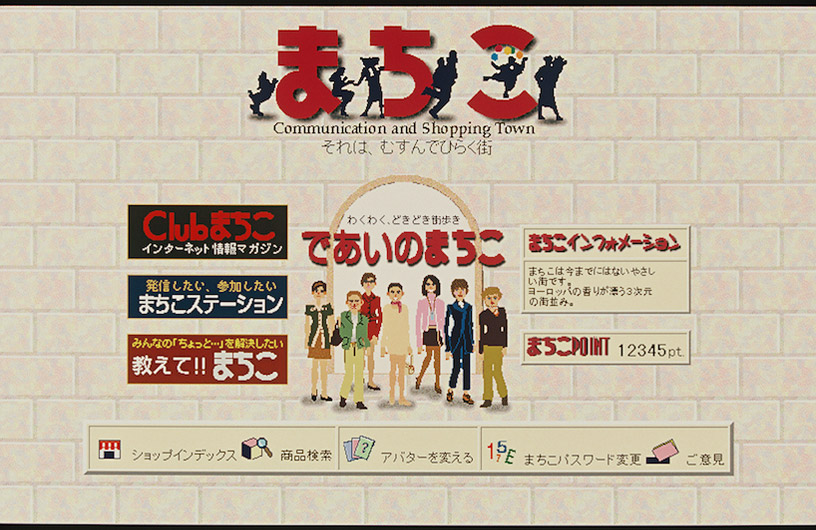
- Services
- Started providing the service "Koufuri Kun" which notifies customers in advance of their utility charges, such as electricity, telephone, gas, and water bills. It was also possible to create links with accounting systems, improving the overall efficiency of payments.
-
- 1995
-
- Management
- Introduced Intrapreneurship, where all employees could propose management strategies and become project leaders for in-house projects.
- Services
- Started sales of a wide-area disaster information system and EMIS (Emergency Medical Information System), which provided simultaneous communication to various parties in the event of a disaster.
- 1994
-
- Technology
- Developed a "Virtual Mall" (virtual shopping mall), a first in Japan, which laid the foundation for future NTT technology.
- 1993
-
- Management
-
Received the Deming Application Prize 1993, a first for the information service industry.
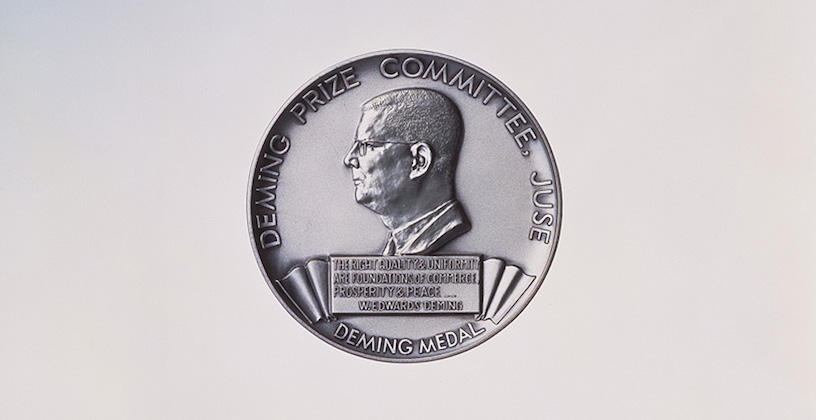
- 1992
-
- Services
-
Procured 6 million smart cards at a time where the annual shipment was still only in the hundreds of thousands. This helped solidify the IC card market by making them cheaper and more widely available.
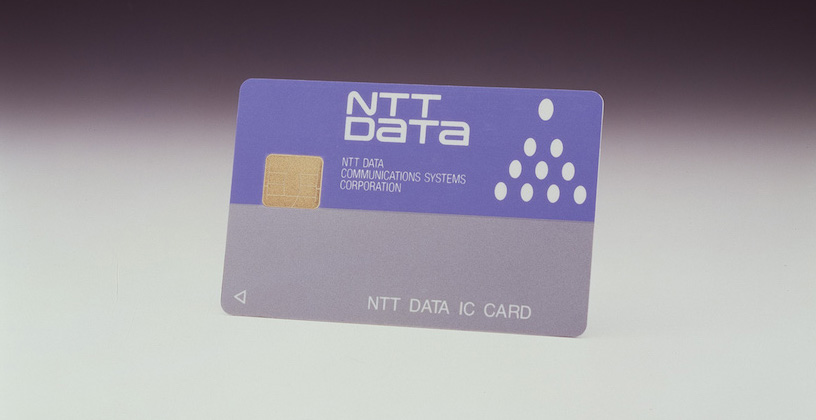
- 1991
-
- Management
- Established a branch office in the UK, the first expansion into Europe, with the mission to support systems developed for Japanese financial institutions.
- Services
- Started The Tokyo Commodity Exchange and Tokyo International Financial Futures Exchange systems, creating an environment where trading participants could more easily obtain further business opportunities.
- 1990
-
- Management
- Established a branch office in the USA, the first foreign expansion for NTT DATA aiming to support NTT DATA's global activities from overseas.
- 1988
-
- Management
-
NTT DATA Communications Systems Corporation spun off into a separate company from NTT, quickly becoming the largest information and communication service company in Japan
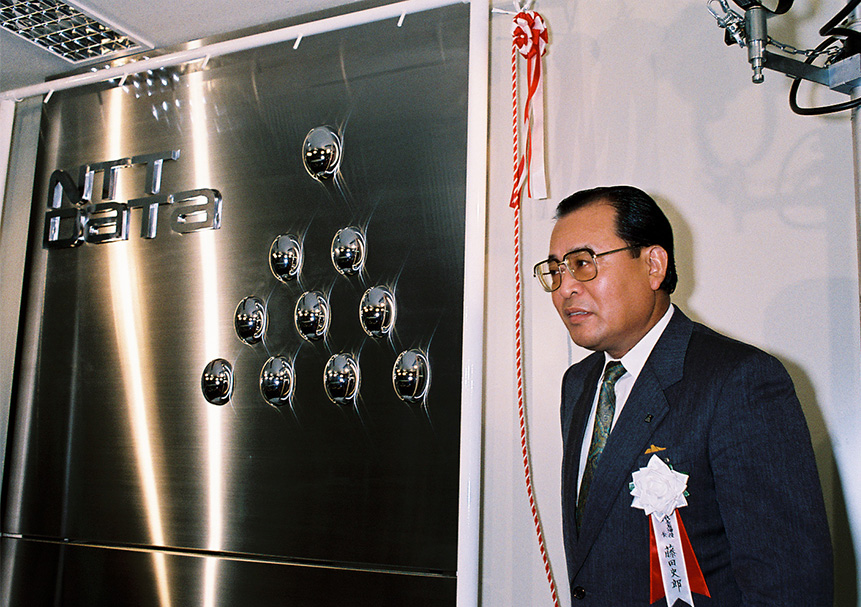
- Services
- Developed a domestic standard S-type IC card in collaboration with 15 domestic companies.
1967-1987
Early Period
“The Beginning of Data Communication Services”
Every history has a beginning. Our story begins in 1967, with the birth of modern “Data Communication” which is a combination of telecommunication technology and personal computer.
During this period Japanese economy was growing rapidly and so was Japanese technology.
Data Communication started operating in full scale in Japan.
In 1967, The Nippon Telegraph and Telephone Public Corporation, known as NTT, decided to establish the DATA Communications Bureau, known as NTT DATA, within in it.
Since then we have led information service industry while developing our business mainly in social infrastructure and computer systems in Japan.
We succeeded in a number of large-scale projects such as “Zengin System” which enabled 705 banks in Japan to transfer money online. It was one of the most innovative technologies using data communication in 1973.

- 1985
-
- Management
- With communication becoming freer, Nippon Telegraph and Telephone Corporation (NTT) was privatized, leading to the creation of future NTT companies.
- 1984
-
- Services
-
Credit And Finance Information Switching system “CAFIS service” launched in preparation for the rapid expansion of credit card use, becoming Japan's biggest cashless payment platform.
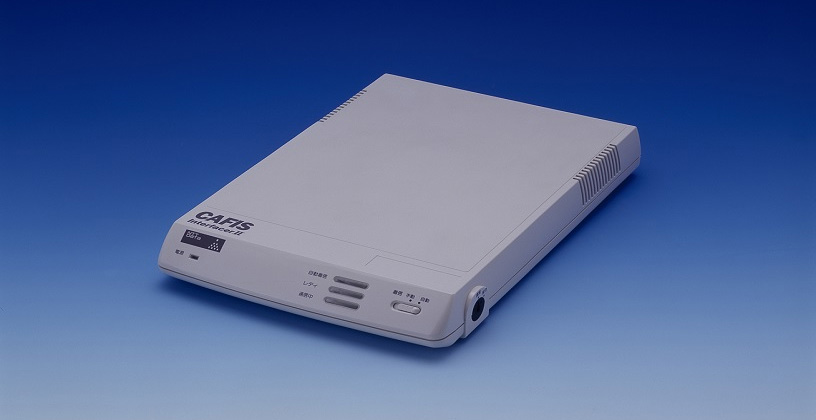
- 1981
-
- Services
- The financial "ANSER System" (Automatic answer Network System for Electrical Request) commenced, allowing users to perform various financial tasks, such as bank transfers, all while reducing system costs through the sharing of technology.
- Services
- The ultra-large-scale mainframe computer DIPS-11 (Dendenkosha Information Processing System) Model is developed, dramatically increasing memory and introducing a service processor.
- 1978
-
- Services
- Nippon Automated Cargo and Port Consolidated System "NACCS" installed at Narita International Airport supporting customs clearance, now available at all major airports and ports, providing customs clearance and trading services.
- Services
- Radar Data Processing System "RDP System" is launched with an emphasis on providing real-time flight data to air traffic controllers all over Japan.
- 1973
-
- Services
- The "Zengin System" is set up, equipping banks across Japan with an online network system for immediate transfer of funds, a showcase for a top-class online transfer system.
- 1971
-
- Services
- The Dendenkosha Multi-access Online System "DEMOS" is started, providing users the ability to perform more advanced, scientific calculations.
- 1970
-
- Services
- The Denden Realtime Sales Management System "DRESS" and Dendenkosha Immediate Arithmetic and Library System "DIALS" are commenced, allowing users to input data about their business, while also providing basic calculation services.
- 1968
-
- Services
- The Currency exchange "system of Regional Banks Association of Japan" was established, allowing banks to connect and exchange with 63 regional banks all over Japan.
- 1967
-
- Management
-
Nippon Telegraph and Telephone Public Corporation established the DATA Communications Bureau with the mission of promoting the use of computers in Japan while fostering the Japanese computing industry through the development of public, national, and technology leading systems.
